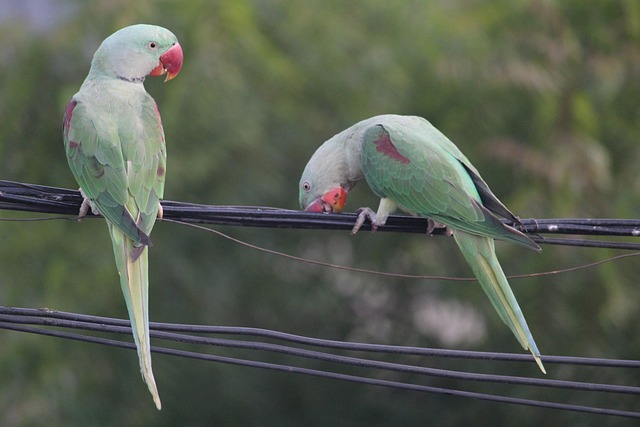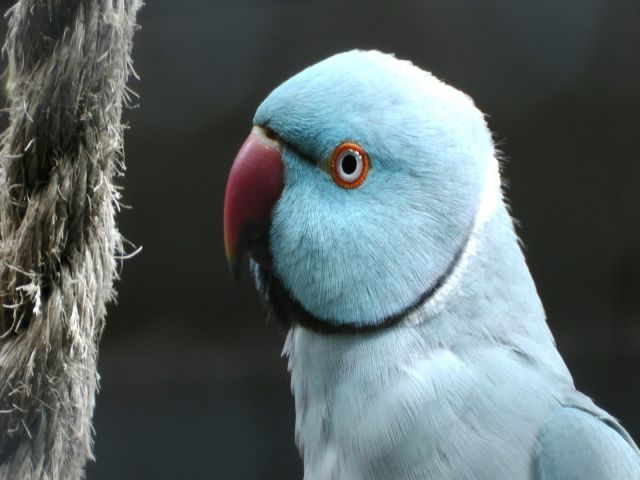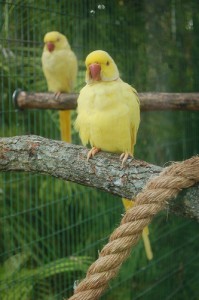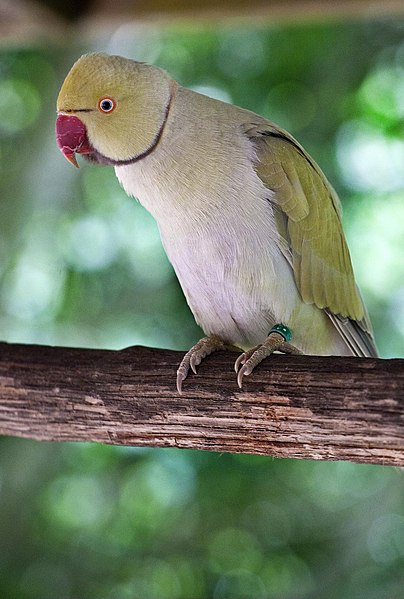The Ringneck Parakeet is also known as the Rose-Ringed Parakeet or the Indian Ringed Parakeet.
There are four subspecies:
- P. krameri borealis, Boreal or Neumann’s ringneck Parakeet originates in east Pakistan, northern India, and Nepal to central Burma.
- P. krameri krameri, an African ringneck Parakeet originates in West Africa in Guinea, Senegal, and southern Mauretania, east to Western Uganda, Eastern South Africa, and Southern Sudan.
- P. krameri parvirostris, Abyssinian-ringneck Parakeet originates in Northwest Somalia, west across northern Ethiopia to the Sennar district, Sudan.
- P. krameri manillensis, Indian-ringneck Parakeet originates from the southern Indian subcontinent; and has feral populations worldwide.
This article focuses on the unique characteristics of the Indian Ringneck parakeet.

Price of Indian Ringnecks
Ringnecks that have unique color mutations can be quite expensive ranging in price all the way up to $1000. Standard Indian Ringnecks generally cost $100-$200 from a breeder or your local pet store.
Characteristics
The Indian Ringneck is a moderate-sized bird averaging 14-16 inches long with almost half of its length in its tail feathers. Wild Indian Ringnecks are primarily green with a red beak topped off in black on the upper mandible. The Indian Ringneck is known for beautiful color mutations including l blue, white, and yellow.
At sexual maturity, approximately 2 years of age, the male birds of the species grow a black ring with pink and pale blue outer rings under their chin and upwards toward their cheeks. The females also grow rings but they are generally very pale and difficult to see.
Indian Ringneck Parakeets do not bond with a mate for life. The female lays two to six eggs one to two days apart. The eggs hatch between 22 and 24 days and the young are independent at about seven weeks.
The Indian Ringneck is an extremely social bird. In the wild, they tend to form large flocks. In captivity, they’ll bond well with most family members, and with proper socialization and regular interaction they can become happy and compatible family members.
They’re typically noisy birds with active chatter and the ability to learn to speak large vocabularies and mimic a number of sounds. The males are known to be better ‘talkers’ than the females. They live approximately 25 years in captivity.
The Indian Ringneck is incredibly adaptable. They’ve been able to live in the wild quite successfully from the Florida coast up to the Midwest and eastern states. They’re banned in some locations due to the fact that they’re not native to the areas and they are thought to cause crop damage.
Indian Ringnecks are incredibly intelligent and must be kept active and engaged. When you’re not able to interact with them it is best to keep them in a large cage, preferably an aviary where they can fly and move about, with an abundance of toys for chewing, climbing, and puzzle toys to solve.
When you’re interacting with your Indian Ringneck trick training is an ideal way to pass the time. Training engages their problem-solving skills, broadens their vocabulary and it teaches them not only tricks but day-to-day routines that make living with an Indian Ringneck easier and more pleasant.

Caring for Indian Ringnecks
The Indian Ringneck Parakeet loves to fly. Seems like an obvious statement but these birds are particularly good at it and if you can provide them an aviary in addition to or instead of a cage they’ll be extremely happy and well exercised.
What Cage To Get Indian Ringnecks
If you can’t swing an aviary then the biggest cage you can fit into your home, at least larger than 36″h x 18″d x 24″w, is acceptable.
Because Indian Ringnecks are also chewers, it is important to make sure the cage is made out of stainless steel or steel coated with non-toxic and non-chipping paint. This is extremely important because you don’t want your parakeet chewing on the bars and swallowing paint.
In addition to quality material, it is important to make sure that the cage is safe and convenient.
Convenience features include a wire bottom grate with a pull-out tray that is easy to clean, casters so you can move the cage about your home easily, and a number of perches so your Indian Ringneck has an opportunity to develop strong and healthy feet and can move about their cage freely.
Safety features include bars that are not spaced too far apart. Less than one inch is preferable, a door that opens like a drawbridge or like a normal door in your home, not like a guillotine which can trap them and cause injury.

Cage location can be extremely important. Look for a location that is free from drafts yet allows your Indian Ringneck to get natural sunlight during the day. Also, look for a location that enables your parakeet the ability to be part of the family and still feel safe and protected.
For example, against the wall or in the corner of your family room may be ideal because it places your bird in the room where you and your family generally hang out, and against the wall means your Indian Ringneck only needs to protect two or three sides of their cage rather than feeling vulnerable all the way around it.
Inside the cage make sure you provide your Indian Ringneck with a variety of toys. Look for toys that give your parakeet the opportunity to express their chewing tendencies as well as toys that give them a mental challenge and require them to solve puzzles. Of course, toys that are just fun to play with and climb are good too.
Look for a variety of colors, shapes, materials, textures, and sizes. Your Indian Ringneck won’t like every single toy you give them so pay attention to the toys they do like and remove the ones they don’t.

What to Feed Indian Ringnecks
In addition to giving your Indian Ringneck parakeet a proper caging environment, it is important to feed them well. There are a few foods that your parakeet must not eat.
They include avocados, caffeine, chocolate, and alcohol. Probably not what you were going to feed them anyway but it’s important to make sure they don’t accidentally get into those foods – they’re toxic.
So what do you feed your Indian Ringneck? Start with a good organic pellet-based diet and supplement it daily with fresh fruits and vegetables.
The more variety you offer them when they’re young, the more variety they’ll like when they’re older and the healthier they’ll be. Parakeet doesn’t live on apples and carrots alone. They need green veggies, berries, melon, and much much more.
But what about seeds and nuts you ask? Save these fatty and delicious treats for trick training and treats. Too many seeds and nuts and your Indian Ringneck can become overweight and ill.
The last thing to consider is routine cage cleaning, grooming, and making sure your Indian Ringneck gets enough quality sleep each night. Shoot for approximately 11 to 12 hours of sleep each night for a happy and healthy parakeet. Proper care and a little TLC will help make sure your Indian Ringneck lives a great long life free of disease and happily interacting with you and your family.
